
I am a rock, I am an island.
Paul Simon could have been describing Anacapa, just off the California coast. We don’t think he was, but it is a practically perfect fit.
On clear days we have been able to spot the rocky outcrop poking out of the Pacific since we moved to our new home in Ventura.
The sight of the arch off in the distance beckoned with a call like a siren’s song, so a boat ride was inevitable.
 With several trips a day leaving from the marina near our little beachside hideaway, we didn’t have far to go to begin our trek.
With several trips a day leaving from the marina near our little beachside hideaway, we didn’t have far to go to begin our trek.
We chose a wildlife tour just like whale watching Los Angeles, hoping to catch a peek at some whales since it was the right time of year to see gray whales on their annual migration, and climbed aboard.
Between December and April these giant mammals pass through the channel between the islands and the California coast as they travel between their winter breeding grounds off of Baja and their summer feeding area near Alaska. Later in the year humpbacks and sometimes blue whales can be spotted among the islands.
While we were skunked in the whale sighting department, we did manage to engage in several other wildlife encounters.
As we cruised seaward, our first evidence of animal activity was of the human variety, an enormous oil drilling platform stood in our path. Not exactly what we hoped for, but interesting none the less.

These mammoth rigs can drill and service dozens of wells from each location. This helps to keep their disruption of the landscape down somewhat, because instead of hundreds of visible wells in the waters of the Santa Barbara Channel between the coast and the islands off of Southern California, there are only 32.
The ones we saw are all still active, but when they are no longer they can also be refurbished into an eco-friendly use as artificial reefs so at least there is ultimately some eco-friendly outcome.
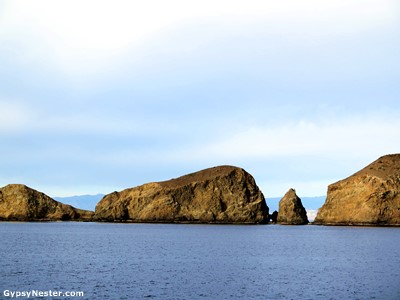 After passing within a few hundred feet of the structure, we made way for the rocky outcrops of the southern tip of Anacapa, which is the smallest and closest of the eight islands known as the Channel Islands. The northernmost five of these have been set aside as Channel Islands National Park and the waters around them protected as the Channel Islands National Marine Sanctuary.
After passing within a few hundred feet of the structure, we made way for the rocky outcrops of the southern tip of Anacapa, which is the smallest and closest of the eight islands known as the Channel Islands. The northernmost five of these have been set aside as Channel Islands National Park and the waters around them protected as the Channel Islands National Marine Sanctuary.
Approaching the island, we skirted along the shore and our captain pointed out a cave that had once been a base for human habitation since it is the only regular source of fresh water. In times of no rain, which is most of the time, condensation within the cave will provide a small amount to drink.
 It must have been enough to sustain life because a few hermits have been known to make a home on the desolate outcrop over the years, the most famous being Raymond “Frenchy” LeDreau, who survived for 28 years before finally returning to the mainland.
It must have been enough to sustain life because a few hermits have been known to make a home on the desolate outcrop over the years, the most famous being Raymond “Frenchy” LeDreau, who survived for 28 years before finally returning to the mainland.
It was also along this shore that we saw the greatest concentration of birds.
In our travels we have found that birds love islands, and this was certainly no exception. Massive congregations of gulls had assembled, which were impressive, but we were much more intrigued by the pelicans that flew by us with their wingtips only inches above the surface of the sea.
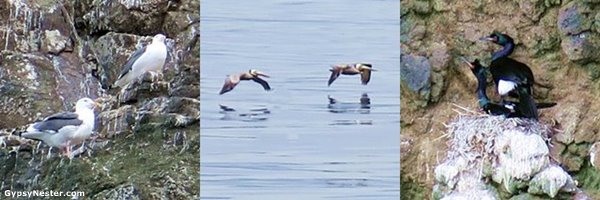
We also spotted a nesting pair of cormorants precariously perched on the cliff face opposite the landing when we pulled up to the island’s only dock to pick up a group of hikers.
With our new shipmates safely aboard, we headed for the sea arch that is Anacapa’s most famous feature. This stark, volcanic rock formation standing out against the ocean was what lured us out to sea and the close up view was well worth the voyage.
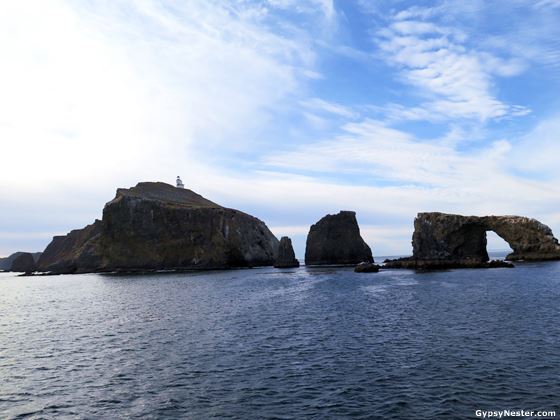
Perhaps it was also what enticed the region’s native people to become some of North America’s very first seafarers some 13,000 years ago. At least as far as we know they were, since these islands are where the continent’s oldest evidence of marine travel has been found.
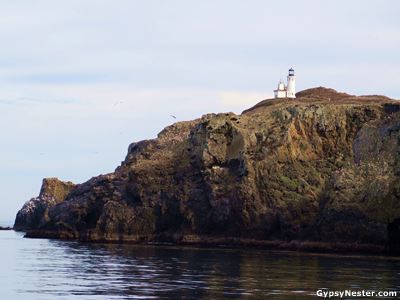 Beautiful as the formations may be, they are also dangerous to any sailor navigating these waters, so in 1932 a lighthouse was built on the point above the rocks to warn mariners to steer clear.
Beautiful as the formations may be, they are also dangerous to any sailor navigating these waters, so in 1932 a lighthouse was built on the point above the rocks to warn mariners to steer clear.
Fortunately, we safely rounded the island’s rocky tip and sailed along the back side, the shore away from the mainland, toward the passage between Anacapa and the island of Santa Cruz. Before we could shoot that gap we noticed several beaches where elephant seals had taken up residence.
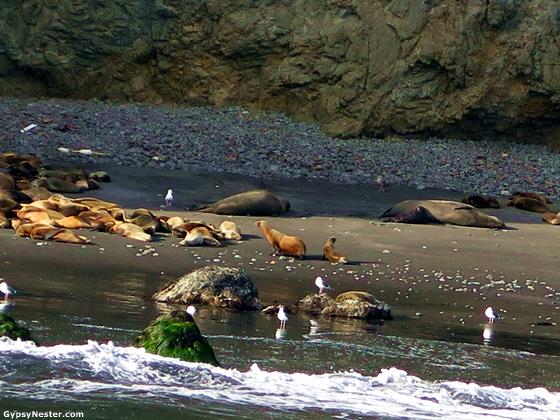 They were believed to be extinct early in the last century, but the Channel Islands played a role in their remarkable comeback. Now they are plentiful again, still we did think it strange to see them lounging with a group of their much smaller cousins, California Sea Lions. Then it occurred to us, who can resist a day at the beach?
They were believed to be extinct early in the last century, but the Channel Islands played a role in their remarkable comeback. Now they are plentiful again, still we did think it strange to see them lounging with a group of their much smaller cousins, California Sea Lions. Then it occurred to us, who can resist a day at the beach?
When we turned back toward Ventura, we got our closest look at the largest of the islands, Santa Cruz, which serves as the main staging area for visitors to the national park. Even though it is the most developed part of the park, this area has extremely limited services.
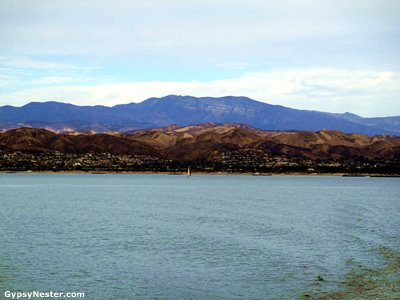 There is no lodging or supplies available, only primitive campsites, which made us content with confining our visit to brushing passed the shoreline while remaining aboard a ship.
There is no lodging or supplies available, only primitive campsites, which made us content with confining our visit to brushing passed the shoreline while remaining aboard a ship.
There is an option to stay on one of the islands that appeals to those of us who prefer more of life’s little comforts, but it is not part of the national park. As the only island with any population to speak of Santa Catalina, off the coast of Los Angeles, has become extremely popular for quick getaways from the city.
Fitting, since getaways seem to have been the mainstay of these islands from the time the first natives spotted them off in the distance, through pirates, hermits, and rum runners, up to today’s backpackers, hikers, boaters, and birders.
David & Veronica, GypsyNester.com



Great site. Lots of useful info here.
I love how this travel blog combines practical advice with personal anecdotes. It’s like having a friend guiding you through the best travel experiences. Your tips on packing, budgeting, and navigating unfamiliar territories are incredibly helpful. Your blog has become my go-to resource for all things travel-related!
A very interesting articel!!! And pictures are beautiful. They show the beauty of California. I dream of such journey.
What impressed you the most?
The sea arch was probably our favorite.
beautiful images. Yes you’re right about blue whales, I seen those whales among the islands
very best blog about California Chanel islands. Best guide about tours. Thank you very much for best blog.